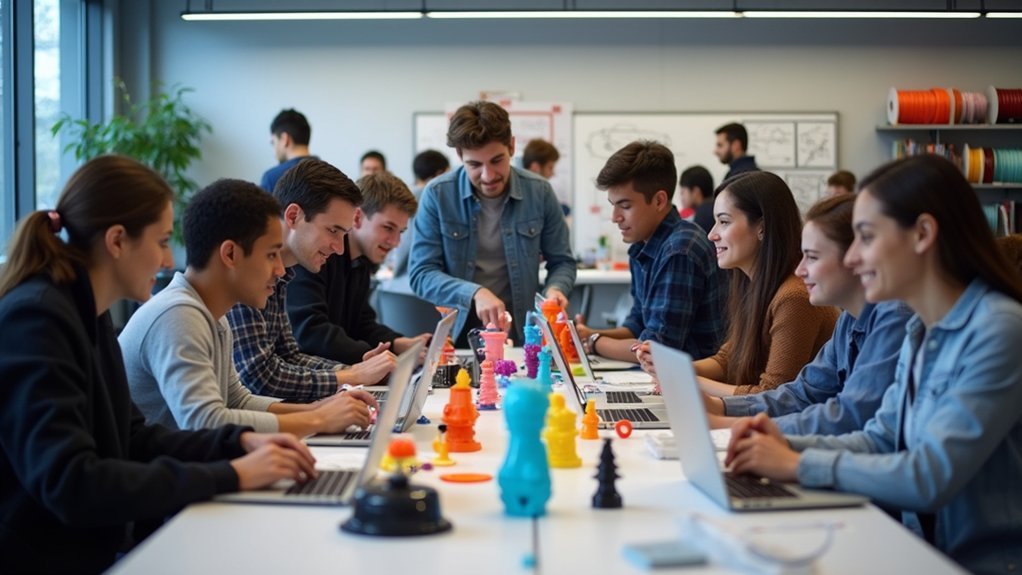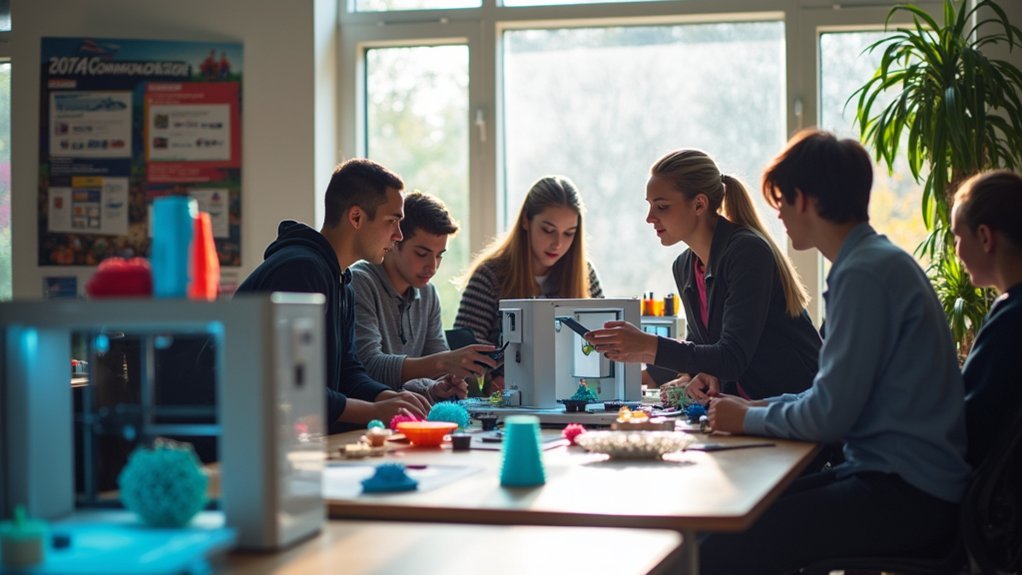You can implement affordable 3D printing at your university by selecting budget-friendly FFF and SLA printers with open filament systems, which have dropped 30% in price over the past decade. Establish centralized makerspace labs to maximize resource sharing and train faculty and students through hands-on workshops. Secure industry partnerships for equipment subsidies and material discounts, while pursuing federal grants from NSF and Department of Education. These strategies will help you access thorough implementation methods.
Budget-Friendly 3D Printer Selection and Procurement Strategies

Budget constraints shouldn’t prevent your university from embracing 3D printing technology.
With FFF and SLA printer prices dropping 30% over the past decade, affordable options are now within reach for most educational institutions.
When selecting a budget-friendly 3D printer, prioritize open filament systems that accept cheaper third-party materials, greatly reducing ongoing operational costs.
Research successful case studies from similar institutions to guide your procurement decisions effectively.
Focus on user-friendly designs requiring minimal calibration to reduce training expenses and streamline implementation.
Consider establishing centralized 3D printing labs rather than department-specific purchases to maximize resource sharing and impact.
This approach democratizes access across campus while stretching your budget further, ensuring multiple departments benefit from strategic technology investments.
Establishing Cost-Effective Makerspace Labs on Campus
While centralized procurement strategies lay the foundation for affordable 3D printing, creating a dedicated makerspace lab transforms individual printer purchases into a collaborative innovation hub.
You’ll foster creativity and experimentation by establishing a space where students engage in hands-on learning with 3D printing technology. Equip workstations with design software and train knowledgeable student assistants to enhance the learning experience and encourage peer collaboration.
Your makerspace democratizes access to advanced manufacturing tools, enabling students from different backgrounds to participate in innovative projects.
A makerspace breaks down barriers, giving every student equal opportunity to explore advanced manufacturing and bring creative visions to life.
By incorporating 3D printing across disciplines—from engineering to art—you’ll promote interdisciplinary collaboration and enrich education campus-wide.
This centralized approach maximizes shared resources while reducing individual department costs, creating sustainable access to cutting-edge technology.
Training Faculty and Students for Maximum Equipment Utilization

You’ll maximize your 3D printing investment by implementing thorough hands-on workshop sessions that teach faculty and students essential operation and troubleshooting skills.
These interactive training programs should cover everything from basic printer setup to advanced design techniques, ensuring users can confidently navigate the technology independently.
Establishing ongoing technical support systems creates a safety net that keeps your equipment running efficiently while building user confidence through continuous learning opportunities.
Hands-On Workshop Sessions
Although 3D printers can transform educational outcomes, their impact depends entirely on how well faculty and students can operate them.
You’ll maximize equipment value by conducting hands-on workshop sessions that provide practical training in printer operation and troubleshooting common issues. These learning experiences should focus on real-world scenarios participants will encounter daily.
Structure your workshops around core competencies: basic printer setup, material loading, print monitoring, and problem resolution.
You can’t replace hands-on experience with theoretical instruction alone. Participants need to physically operate equipment, encounter actual printing challenges, and develop muscle memory for routine procedures.
Design sessions that progress from fundamental operations to advanced techniques. Each workshop should include guided practice time where participants complete actual printing projects while receiving immediate feedback and support.
Ongoing Technical Support
Since initial workshops provide foundational skills, you’ll need structured ongoing support to maintain proficiency and address evolving challenges.
Establish a student-led makerspace where knowledgeable assistants help peers navigate printing technology complexities. This peer-to-peer model creates sustainable support while developing leadership skills among advanced users.
Schedule regular update workshops to keep students and faculty informed about the latest advancements in 3D printing. These sessions should cover new software features, material innovations, and troubleshooting techniques.
Integrate manufacturer educational resources to enhance design capabilities and technical understanding.
Create accessible documentation and video tutorials for common issues. Maintain an online forum where users can share solutions and best practices.
This thorough ongoing support system guarantees your 3D printing program continues delivering maximum educational value while building a self-sufficient community of skilled users.
Cross-Disciplinary Applications to Justify Investment Costs
When universities invest in 3D printing technology, they can maximize their return by implementing cross-disciplinary applications that serve multiple departments simultaneously.
You’ll find that history students can recreate ancient artifacts for experiential learning, while biology classes utilize anatomical models to deepen comprehension of complex structures.
Art students experiment with sculptural prototypes, bridging creativity and technology effectively.
Your engineering and design courses will see improved project outcomes, preparing students for the additive manufacturing sector projected to reach $51 billion by 2030.
These cross-disciplinary projects encourage collaboration among diverse fields, developing critical thinking and problem-solving skills.
Partnerships With Industry to Subsidize Equipment and Materials

You can greatly reduce your university’s 3D printing costs by establishing corporate sponsorship programs that provide direct funding for equipment purchases and ongoing maintenance.
These partnerships often include material cost agreements where industry partners supply filaments, resins, and other consumables at discounted rates or through bulk purchasing arrangements.
You’ll find that companies are willing to invest in these educational partnerships because they gain access to research collaboration opportunities and a pipeline of skilled graduates familiar with their technologies.
Corporate Sponsorship Programs
Although budget constraints often limit universities’ access to advanced 3D printing technology, corporate sponsorship programs offer a powerful solution that transforms financial challenges into collaborative opportunities.
You’ll find that these programs markedly reduce costs by securing funding for 3D printing equipment and materials from industry partners. When you establish relationships with companies like Markforged, you can obtain high-quality printers through donations or subsidized pricing arrangements.
Your industry partnerships create mutually beneficial scenarios where students work on real-world projects while companies access university resources.
You can attract sponsored research projects that align educational programs with market demands. By developing a clear sponsorship framework, you’ll diversify funding sources and build long-term relationships that sustain your 3D printing initiatives while providing valuable industry experience for students.
Material Cost Agreements
Material cost agreements represent one of the most effective strategies for universities seeking to dramatically reduce their 3D printing expenses while building valuable industry connections.
These partnerships enable educational institutions to secure subsidized equipment and materials through strategic collaborations with local manufacturers and technology companies.
Through material cost agreements, you’ll gain access to:
- Bulk purchasing discounts on essential materials like PLA and ABS plastics
- Subsidized 3D printing equipment through industry partnerships
- Shared resources including expertise and technical support
- Real-world application opportunities that enhance student learning
Maintenance and Material Management for Long-Term Savings
While upfront costs often dominate discussions about 3D printing budgets, the real financial impact emerges through ongoing maintenance and material expenses that can make or break your university’s long-term investment.
Regular maintenance dramatically extends printer lifespan while preventing costly repairs and downtime. You’ll achieve substantial cost savings by training staff and students on proper protocols rather than relying on expensive external technicians.
Smart material management starts with open filament systems, letting you source cheaper third-party options instead of proprietary alternatives.
Implement centralized inventory control to minimize waste and optimize resource utilization.
Don’t overlook partnership opportunities with local suppliers who can provide discounted materials and maintenance services. This collaborative approach creates sustainable cost structures that support your program’s growth while maintaining quality educational outcomes.
Grant Funding and Financial Aid Opportunities for 3D Printing Programs
Beyond implementing smart maintenance and material strategies, you can greatly reduce your 3D printing program costs through strategic grant funding and financial aid opportunities.
Multiple funding sources exist to support your educational initiatives.
You’ll find excellent funding through these key sources:
- Federal agencies like NSF and Department of Education that specifically fund innovative STEM education tools
- State-level programs targeting advanced manufacturing technologies for workforce development in educational settings
- Local partnerships with businesses and non-profits offering sponsorship or co-funding for 3D printing projects
- Student financial aid programs helping cover materials and workshop costs for low-income students
Competitive grants focusing on additive manufacturing research can fund equipment purchases, materials, and training resources.
These 3D printing programs become considerably more affordable when you actively pursue these financial aid opportunities.
Measuring Return on Investment Through Student Outcomes and Engagement
When you invest in affordable 3D printing programs, you’ll need concrete metrics to demonstrate their educational value and justify continued funding. Track student outcomes through improved academic performance, retention rates, and enhanced critical thinking skills demonstrated by students utilizing 3D printing technology.
Measure engagement levels by monitoring increased participation in STEM courses and hands-on project completion rates.
Track STEM enrollment increases and project completion metrics to quantify how 3D printing technology boosts student engagement.
Document collaboration improvements across disciplines, as universities report stronger teamwork skills when students access 3D printing resources.
Calculate cost savings from rapid prototyping versus traditional materials while evaluating the technology’s impact on problem-solving abilities essential for design and engineering careers.
These measurable benefits in student outcomes and engagement provide compelling evidence that 3D printing delivers substantial educational returns, supporting budget requests for program expansion.
Frequently Asked Questions
How to Make 3D Printing Cheaper?
You can reduce 3D printing costs by choosing open filament systems, buying cheaper third-party materials, sharing centralized resources, minimizing waste through digital corrections, and selecting affordable FFF or SLA printers.
What Role Do Schools Play in Using 3D Printing Technology?
You’ll find schools integrate 3D printing across disciplines, creating makerspaces for collaborative learning. They enhance STEM education, develop students’ technical skills, and engage with communities through research projects, preparing you for additive manufacturing careers.
What Is the 45 Degree Rule for 3D Printing?
You’ll need support structures when printing overhangs exceeding 45 degrees from vertical. This rule minimizes material waste, reduces print time, and helps you design more efficient models while understanding 3D printing’s physical limitations.
How Does 3D Printing Reduce Costs?
You’ll save money through cheaper equipment prices, affordable third-party filaments, minimal material waste, and precision manufacturing. You’re avoiding expensive traditional tools while using cost-effective plastics for small-scale production.





Leave a Reply